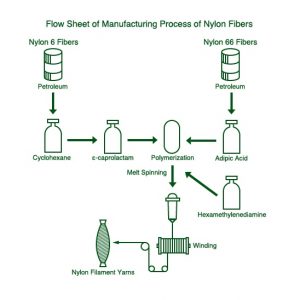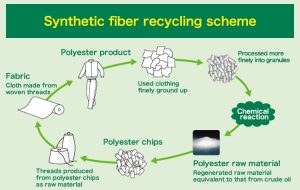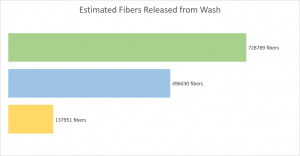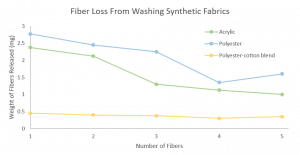Although polyester suits are no longer a fashion statement like they were in the ’70s, polyester and other synthetic materials such as nylon are still very popular materials used to make clothes due to their accessibility, durability and cost-effectiveness. Polyester, nylon and acrylic fibers are among the most popular synthetic fibers on the market. As their name would imply, synthetic fibers are manmade, synthesized fibers and are petroleum-based products.

Figure 1: The manufacturing process of synthetic nylon fibers. Source: Japan Chemical Fibers Association
One of the advantages and appeals of synthetic fibers is that they can be made using recycled materials. This recycled material can be old polyester materials themselves or can even be old plastic water bottles or other recyclable plastic products. There are many companies actively working to use recycled materials to make their apparel and while this may seem beneficial and an excellent solution to fully utilize plastic products to their full potential, it may actually be a double-edged sword. More people could be inclined to use plastic products, as they would assume that the plastic will be recycled properly. Unfortunately, that is not often the case. Not all the plastic products on the market are recycled responsibly and instead can contribute even more to the growing plastic pollution and microplastic issue as mentioned in my previous post. But even when plastic IS effectively recycled to make new fabric, there still is another hidden micro problem, a microfiber problem.

Figure 2: The cycle of synthetic polyester apparel made from recycled materials. Source: Japan Chemical Fibers Association
The video above outlines the not so micro issue surrounding microfibers.
Essentially, every time you wash a piece of clothing made of synthetic materials, tiny fibers or pieces of plastic, called microfibers are released. These microfibers are a type of microplastic since they are essentially micro pieces of plastic. It causes an issue due to the microfibers being too small and bypassing the filters in both our washing machines and at water waste treatment sites.

Figure 3: The estimated amount of fibers released from every wash for three synthetic fibers commonly used in the textile industry. Source for data.
This study estimates the amount of microfibers released (in mg) after the first five washes of 6 kg (the weight of a typical load of laundry) of three different types of commonly used synthetic materials. Figure 4 illustrates the data from their study. While looking at this data, it can be concluded that after the first five washes, the number of microfibers released decreases. However, other studies conclude the opposite—that the amount of microfibers released actually increases the more that the clothing items are washed due to the degradation of the product and the loss of structural integrity.

Figure 4: The amount of fibers (in mg) released from washing 6 kg of synthetic material. Source for data.
So, what can be done to mitigate the amount of microfibers entering our waterways and contributing to the alarming microplastics issue? Some studies suggest implementing better, higher quality filters in waste treatment plants and found them to be extremely effective at trapping these microfibers, decreasing the amount of microplastics entering waterways by 98%. Additionally, there have been other suggestions that include using proteins found in squids to make a biomaterial that can be used to make fabrics. The simplest solution, however, is to just be more conscientious about the products you purchase. By looking for products that have blends of both synthetic and natural fibers not only can recycled materials be incorporated, but also the integrity of the fabrics is improved to prevent less microfiber shedding, leading to the best of both worlds.
~Isla
